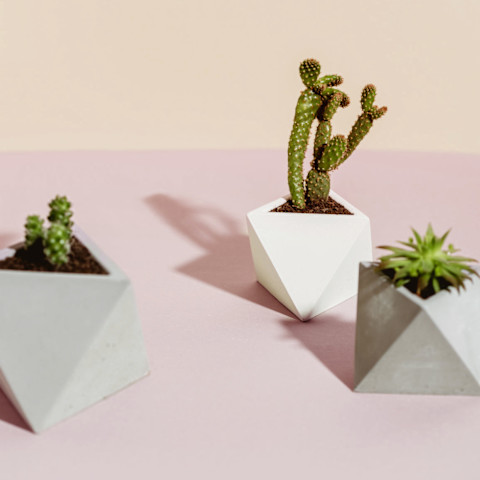Solved: This Is The Right Way To Water Your Plants (And Bring Them Back To Life If They're Dead)

The simple act of watering creates a lot of worry among houseplant owners. We tend to fall into two camps: those who neglect them for weeks and those who water too much.
Neither scenario is ideal, but overwatering is actually the No. 1 cause of houseplant death (!) That's because a lot of people think that if a plant's dirt isn't saturated at all times, it will die of thirst. In fact, the opposite is true: Very moist soil rots the roots, killing the plant. And because the signs of under- and overwatering are largely the same (either way, the plant wilts), people often water the plant some more in the hope that it will help. It's a vicious cycle.
OK, so how can I make sure I'm watering my plant just right?
At the end of the day, less is often more when it comes to watering. But it's hard to say exactly how much you should be watering all of your plants since it depends on its size, leaves, location in your home, and even the type of its pot (terra-cotta dries out more quickly than plastic!). But as a rule of thumb, every one or two weeks in spring and summer, and slightly less often in winter, is about right. Here are my tips for watering effectively:
1. Don't water on a schedule.
And don't water everything just because you've got the watering can out! Get to know your plants and you'll notice that some dry out more quickly than others.
2. Allocate watering duties to one member of your household.
This will help you avoid accidental overwatering.
A pot with very dry soil will feel light.
3. Water most plants when the top 1 cm or 2 cm of compost is dry.
Gently poke a finger into the compost. If the top layer is crumbly and dry, it's time to water. If foliage is covering the surface of the compost, go by the weight of the pot. A pot with very dry soil will feel light.
4. Aim for dirt that is as moist as a wrung-out shirt.
It's a weird analogy, but it works! If the compost is consistently wet and soggy, you've overdone it. The aim is to moisten all of the compost, not just the top. The water needs to get right down to the roots.

5. Use a watering can, or stand plants in a bowl of water.
If you're using a can, pour slowly and gently to avoid the water draining straight through to the saucer below and potentially overflowing onto your furniture. Standing the plant in a dish, bucket, or bowl is a good option for plants that have dried out a lot or those with foliage that covers the compost.
6. Let excess water drain away.
Again, this is to avoid the dreaded soggy compost. Stand plants on a draining board, or pour any excess water out of the plant saucer after half an hour.
7. Use water that is room temperature.
Cold water will shock the plant, especially if it originally hails from a tropical climate.
8. Water less frequently from November to March, unless the plant is in flower.
Most plants are not actively growing in the winter. Plants in centrally heated rooms, however, can dry out, so keep an eye on them.
9. Don't splash water on the leaves.
This can cause unsightly blotches and potentially gray mold.
10. If you have orchids in particular, remember to dip and drain.
Orchids are grown in coarse soil, which makes it hard to tell when they need watering. Put the plant in a bucket or sink of tepid water and leave to stand for 10 minutes. Leave to drain thoroughly. Do this around once a week in spring in summer, less often in autumn and winter.
How to save a wilted, thirsty plant.
First, make sure that your plant is actually thirsty by feeling the soil. If it's dry, move the plant somewhere shady and fill a bowl with tepid water. Dunk the pot into it, weighing it down if it floats. Soak for around 30 minutes and drain. The plant should revive within an hour or two!
How to save a wilted, waterlogged plant.
If the soil is waterlogged, this is much more serious and you may not be able to save your plant. Remove the pot and wrap the root ball with newspaper or paper towels, replacing them until they have soaked up all the moisture. Keep the plant out of direct sun and keep the compost just moist for a few weeks.
Plants that can cope with less water:
- Aloe vera
- Crown of thorns (Euphorbia milii)
- Desert cactuses
- Dragon tree (Dracaena)
- Inch plant (Tradescantia)
- Kalanchoe
- Money plant (Crassula)
- Snake plant (Sansevieria)
- Spider plants (Chlorophytum)
- String of hearts (Ceropegia)
- Yucca
- ZZ plant (Zamioculcas zamiifolia)
